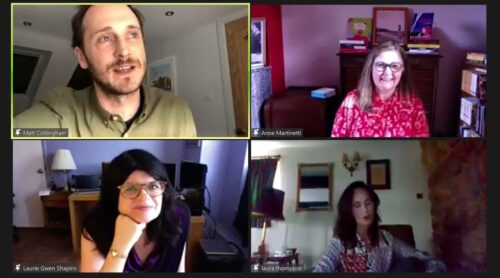One Subject, Three Ways: Agatha Christie

Clockwise from the upper right: Anne Martinetti, Laura Thompson, Laurie Gwen Shapiro, and Matt Cottingham.
Moderator Laurie Gwen Shapiro kicked off the session with the question, “How does the form chosen to tell a subject’s life shape its content?” In this case, the subject was Agatha Christie. Exploring Shapiro’s question were three panelists Zooming in from England and France: Matt Cottingham (in London), who made the documentary Inside the Mind of Agatha Christie; Laura Thompson (just outside London), who is the author of Agatha Christie: A Mysterious Life; and Anne Martinetti (in Paris), who wrote a cookbook based on Christie’s work, called Creams and Punishments, coauthored the graphic biography Agatha: The Real Life of Agatha Christie, and wrote a documentary about Christie’s adaptations in movies, The Inheritance Crime.
For Cottingham, one challenge was remembering that he only had an hour to tell his story—in his first biographical film—and he would need to simplify some parts and keep in mind the film would have a broad audience. Another huge challenge at the outset: finding enough visual material for even just 60 minutes. His first search for video of Christie turned up just three clips, “which is nothing, and they were all about 20 seconds long.” He realized he would need the cooperation of the Christie family to make a film, and fortunately he received it from her grandson. That gave Cottingham access to photos, home videos, and audio recordings, including an autobiography Christie had recorded. In the latter, though, Cottingham found his subject to be “guarded” and there was not enough material to provide a structure for the film. But he did have access to Christie’s “secret notebooks” (as did Thompson), which provided a wealth of information. Cottingham found that certain “dark” parts of Christie’s life were turning points, such as serving as a nurse during World War I or her husband’s infidelity.
Of the three panelists, Thompson took the most traditional biographical approach. Though her subject was well known, Thompson thought there was much that most people didn’t know about her. She focused on the day-to-day of Christie’s life and explored the novels she wrote under another name, “where she could be so honest about herself.”
Thompson also wrote at length about Christie’s “disappearance” in 1926—an 11-day span she never talked about afterward. Thompson called that period a dividing line in Christie’s life and “the heart of her character,” and she treated it by imagining what Christie might have experienced and thought during that time, augmented with what was known from external sources. The newspapers of the time were particularly helpful in that regard, and Thompson also explored places important to Christie’s life. She said, “Going in someone’s footsteps . . . is almost more important than anything.”
Martinetti took the most unusual approaches when examining Christie’s life, with the cookbook and graphic novel. In the former, Martinetti combined her love of cooking with her love of her subject, trying to create something different. She noted that many of Christie’s characters die after eating “excellent meals,” so she tried to recreate the recipes “without poison, of course.” Martinetti found 300 meals in the books and chose to put 80 recipes in her book. She believed that Christie chose to include meals that she loved. Martinetti also saw the value of exploring “place” and had the chance to cook in the kitchen at Greenway, Christie’s home in Devon, England. “It was like she was just by my side,” said Martinetti.
With her graphic novel, Martinetti said the hardest part was choosing which scenes to depict. She tried to focus on scenes that would appeal to young readers, trying to dispel the image of Christie as an old woman. Martinetti also used Hercule Poirot as a character, explaining that he is “near Agatha all the time . . . it was very funny to us to imagine [him] near Agatha during all her life.”
The three biographers found it a privilege and inspiring to explore Christie’s life, each in their own way.